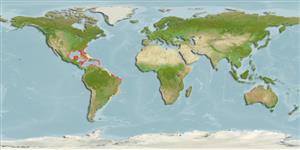Common names from other countries
Classification / Names / Names
ชื่อสามัญ | ชื่อพ้อง | Catalog of Fishes (gen., sp.) | ITIS | CoL | WoRMS
Environment: milieu / climate zone / depth range / distribution range
นิเวศวิทยา
เกี่ยวกับหินโสโครก; กร่อย; ระดับความลึก 2 - 76 m (Ref. 108813). Tropical
Western Atlantic: Caribbean and Gulf of Mexico.
Length at first maturity / ขนาด / น้ำหนัก / Age
Maturity: Lm ? range ? - ? cm Max length : 5.0 cm OT เพศผู้/กระเทย; (Ref. 415)
Thick encrusting; 1 - 5 cm to massive amorphous. Black to dark brown or tan externally on parts unexposed to light, tan internally. Tough, firm, and cartilaginous (Ref. 415).
Maximum thickness: 5 cm (Ref. 415). Occasionally found on mangrove roots and peat banks. Common on reefs and lagoons (Ref. 415). Found on rocky substrates (Ref. 83912). Inhabits seagrasses, mangroves, coralline algae reefs, algal nodules, lower mesophotic and heavily silted reefs (Ref. 128739).
Life cycle and mating behavior
วัยเจริญพันธุ์ | การสืบพันธุ์ | การวางไข่ | เซลสืบพันธ์ของเพศเมีย(ไข่) | ความดกของไข่ | ตัวอ่อน
Members of the class Demospongiae are hermaphroditic. Life cycle: The zygote develops into parenchymella larva (free-swimming) before settling down on a substrate where it grows into a young sponge.
Collin, R., M.C. Díaz, J. Norenburg, R.M. Rocha, J.A. Sánchez, M. Schulze, A. Schwartz and A. Valdés. 2005. (Ref. 415)
IUCN Red List Status (Ref. 130435)
CITES status (Ref. 108899)
Not Evaluated
Not Evaluated
Human uses
| FishSource |
เครื่องมือ
ข้อมูลเพิ่มเติม
Age/SizeการเจริญเติบโตLength-weightLength-lengthสัณฐานวิทยาตัวอ่อนอุดมสมบรูณ์
แหล่งที่มาจากอินเตอร์เน็ต
Estimates based on models
Preferred temperature
(Ref.
115969): 23 - 28, mean 26.1 (based on 296 cells).
Vulnerability
Low vulnerability (10 of 100).
Price category
Unknown.
